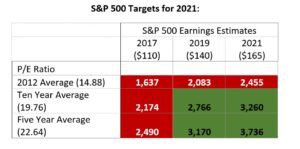2020 First Quarter Review and Outlook
During the first quarter of 2020, the S&P 500 tumbled 35% from an all-time high. The February drop in the market was faster and deeper than the crashes of 1987 and 1929. The coronavirus has disrupted the global economy and people’s daily lives. The coronavirus has created unprecedented uncertainty for the stock market. We feel the pullback in the S&P 500, to levels last seen in 2017, provides a favorable risk/reward opportunity. Therefore, we recommend clients move from the lower end of their equity range to neutral. With low interest rates, we recommend that everyone review their current mortgage rate. This is a great opportunity to refinance your mortgage. The pullback in the stock market is also an opportunity to think about a partial Roth IRA conversion to save on future taxes.
One of the most common ratios used to value the S&P 500 is the price to earnings (P/E) ratio. Most companies have pulled their earnings guidance for the rest of the year. Without guidance on earnings, there is a wide range of possibilities for year-end targets. The slowdown of the global economy will have a significant impact on the S&P 500 earnings for 2020. The price of oil started the year above $50 a barrel and ended the first quarter barely above $20 a barrel. This drop was due to the global slowdown and a price war between Russia and Saudi Arabia. The energy sector made up 5% of S&P 500 earnings in 2019. It is possible that the energy sector posts an earnings loss in 2020. Combining these losses with lower earnings estimates in the industrial sector (11% of earnings) and the materials sector (5% of earnings) and it becomes clear that 2020 earnings will be significantly lower than 2019 earnings. The S&P 500 is at levels not seen since 2017. In 2017, earnings for the S&P 500 were $110 a share. In 2019, earnings were $140 a share. It seems unlikely that 2020 earnings will drop to $110 a share. Before the coronavirus, analysts were estimating $165 a share in 2021 for S&P 500 earnings. More importantly, it seems likely that 2021 earnings could potentially get back to $140 a share.

The next step for the estimating the price to earnings (P/E) ratio is to determine what the market is willing to pay for the S&P 500 earnings. Over the last five years the average P/E is 22.64 based on the last twelve months earnings. Over the last ten years the average P/E is 19.76. The lowest P/E for a year since 1990 was 14.88 in 2011. If someone had purchased the S&P 500 in 2011, they are still up approximately 100% on your investment. While unlikely, if the S&P 500 went under 2,083 we would consider this the opportunity to move equities to the high end of the equity range. We believe that earnings in 2021 will range between $140 and $165. With interest rates close to zero, we expect investors to return to a P/E ratio between the ten-year average (19.76) and the five-year average (22.64). We think a 2021 year-end range for the S&P 500 is 3,170 to 3,260.
For the first quarter the S&P 500 returned -19.60%. Despite the significant pullback in the stock market, growth stocks performed better than value stocks. The S&P 500 Growth Index returned -14.50% for the first quarter compared to the S&P 500 Value Index which returned -25.34%. The P/E ratio for the S&P Growth Index is 24.23 versus the P/E ratio for the S&P Value Index at 13.13. We recommend value companies with strong balance sheets over most growth companies. The S&P Mid-Cap Index returned -29.70% for the first quarter and the S&P Small Cap Index returned -32.64% for the first quarter. We continue to recommend overweighting US large cap stocks versus mid and small cap stocks.
United States equities continued to outperform the rest of the world. International equities, as measured by the MSCI EAFE Index, returned -22.86% for the first quarter. Emerging markets, as measured by the MSCI Emerging Markets Index returned -23.69% for the first quarter.
| US Treasury Rates | ||||
| 1 Year | 5 Year | 10 year | 30 Year | |
| 1/2/2020 | 1.56% | 1.67% | 1.88% | 2.33% |
| 3/9/2020 | 0.31% | 0.46% | 0.54% | 0.99% |
| 3/31/2020 | 0.17% | 0.37% | 0.70% | 1.35% |
In the first quarter, the volatility of the markets was not limited to stocks. The fixed income market also saw extreme volatility. During the first quarter the Federal Reserve cut the federal funds rate from 1.5%-1.75% to 0%-.25%. Due to their liquidity and safety, Treasuries typically appreciate in price (and decrease in yield) during market pullbacks. Investors still purchased the 30-year Treasury bond despite only yielding 2.33% at the beginning of the year. These purchases drove the 30-year Treasury yield down to .99% on March 9th. Thanks to this flight to safety the iShares 20+ Year Treasury Bond ETF returned 22.42% in the first quarter. The Barclays US Aggregate Bond Index only returned 3.15% for the first quarter. The Barclays US Aggregate Bond Index includes corporate and mortgage bonds which explains the lower performance compared to Treasuries. We continue to recommend avoiding high yield and emerging market debt. For the first quarter the High Yield Index returned -11.89% and the JP Morgan Emerging Market Bond index returned -13.70%. The volatility in the fixed income market created several opportunities in corporate and municipal bond markets. We’ve taken advantage of these opportunities by selling Treasuries and purchasing higher yielding fixed income instruments.
At Virtue Asset Management, we view the response to the coronavirus as a three-legged stool. One leg is the health care response, another leg is the monetary policy (Federal Reserve) and the final leg is the fiscal policy (Congress and the President). There is a saying that markets stop panicking when policy makers start panicking. The strongest standing leg has been the monetary policy. Global central banks have pledged the purchase of $7 trillion in assets and have cut interest rates 65 times in 2020. Fiscal policy has been a little slow, and messy in the United States, but eventually $5 trillion globally in fiscal stimulus has been promised. The final leg that needs strengthening is the health care response. In hindsight, the administration was slow to provide a detailed game plan to slow the spread of the virus. Fortunately, some positive steps have been taken to address the health care response. Despite the administration extending social distancing guidelines through the end of April the stock market was up 3% the day the news was announced.
The volatility and pullback in the markets has created opportunities and a more favorable risk/reward profile then we have seen in years. However, the uncertainty of the coronavirus means more volatility over the next few quarters. Due to the uncertainty in earnings and the P/E ratio, stocks have a wide range of values that investors may feel are appropriate. This wide range means investors must be prepared for this volatility before they add to equities to get back to a neutral weighting.
2020 First Quarter Review and Outlook
Investing involves risk, including the possible loss of principal and fluctuation of value. Past performance is no guarantee of future results.
This letter is not intended to be relied upon as forecast, research or investment advice, and is not a recommendation, offer or solicitation to buy or sell any securities or to adopt any investment strategy. The opinions expressed are as of the date noted and may change as subsequent conditions vary. The information and opinions contained in this letter are derived from proprietary and nonproprietary sources deemed by Virtue Asset Management to be reliable. The letter may contain “forward-looking” information that is not purely historical in nature. Such information may include, among other things, projection and forecasts. There is no guarantee that any forecast made will materialize. All information is illustrated gross of investment advisory fees. Reliance upon the information in this letter is at the sole discretion of the reader. Please consult with a Virtue Asset Management financial advisor to ensure that any contemplated transaction in any securities or investment strategy mentioned in this letter align with your overall investment goals, objectives and tolerance for risk. Additional information about Virtue Asset Management is available in its current disclosure documents, Form ADV and Form ADV Part 2A Brochure, which are accessible online via the SEC’s investment Adviser Public Disclosure (IAPD) database at www.adviserinfo.sec.gov, using CRD#283438.
Virtue Asset Management is neither an attorney nor an accountant, and no portion of this content should be interpreted as legal, accounting or tax advice.
Source: Best Financial Advisors in Oak Park | Certified Wealth & Fiduciary Planner | Virtue Asset Management
